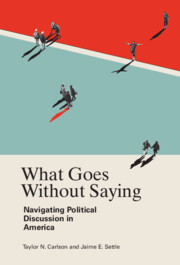Book contents
- What Goes Without Saying
- What Goes Without Saying
- Copyright page
- Contents
- Figures
- Tables
- Acknowledgements
- 1 Opening the Black Box of Political Discussion
- 2 The 4D Framework of Political Discussion
- 3 Data Collection
- 4 Detection
- 5 Decision
- 6 Discussion
- 7 [further] Discussion
- 8 Determination
- 9 Individual Dispositions and the 4D Framework
- 10 The Costs of Conversation
- Notes
- Works Cited
- Index
9 - Individual Dispositions and the 4D Framework
Published online by Cambridge University Press: 26 May 2022
- What Goes Without Saying
- What Goes Without Saying
- Copyright page
- Contents
- Figures
- Tables
- Acknowledgements
- 1 Opening the Black Box of Political Discussion
- 2 The 4D Framework of Political Discussion
- 3 Data Collection
- 4 Detection
- 5 Decision
- 6 Discussion
- 7 [further] Discussion
- 8 Determination
- 9 Individual Dispositions and the 4D Framework
- 10 The Costs of Conversation
- Notes
- Works Cited
- Index
Summary
The final empirical chapter explores how individual differences affect the way people navigate the 4D Framework. After exploring the role of gender, race, political interest, and partisanship strength, we explore how variation in social anxiety, conflict avoidance, and willingness to self-censor are associated with our ability and desire to detect others’ views (Stage 1), the decision to engage in a discussion (Stage 2), the discussion itself (Stage 3) and the aftermath of a discussion (Stage 4). Gender was most influential at the Decision stage, with women being more likely to avoid political discussion. Those most interested in politics and strong partisans were more likely to try to detect others’ political views, engage in a discussion, express their true opinions, and distance themselves from others because of politics. Those who were more socially anxious, willing to self-censor, and conflict avoidant were less likely to directly ask others about their political views at the Detection stage, more likely to avoid political discussions, less likely to express their true opinions, more likely to conform to a group, and more likely to distance from others because of politics.
Keywords
- Type
- Chapter
- Information
- What Goes Without SayingNavigating Political Discussion in America, pp. 202 - 233Publisher: Cambridge University PressPrint publication year: 2022



